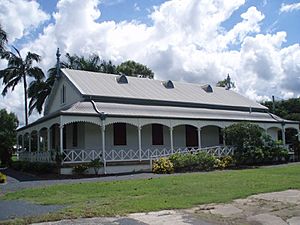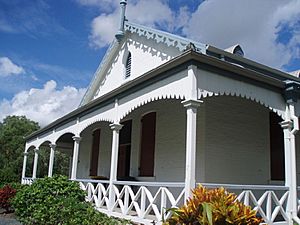North Rockhampton Borough Chambers facts for kids
Quick facts for kids North Rockhampton Borough Chambers |
|
|---|---|

North Rockhampton Borough Chambers, 2009
|
|
| Location | 20 Bridge Street, Berserker, Rockhampton, Rockhampton Region, Queensland, Australia |
| Design period | 1870s - 1890s (late 19th century) |
| Built | 1885 |
| Architect | John William Wilson |
| Official name: North Rockhampton Borough Chambers | |
| Type | state heritage (landscape, built) |
| Designated | 27 September 2002 |
| Reference no. | 601370 |
| Significant period | 1885-1919 (historical) 1885 - ongoing (social) |
| Significant components | trees/plantings, roof/ridge ventilator/s / fleche/s, council chamber/meeting room, views to |
| Builders | Messrs Burton and Smith |
| Lua error in Module:Location_map at line 420: attempt to index field 'wikibase' (a nil value). | |
The North Rockhampton Borough Chambers is a historic building located at 20 Bridge Street in Berserker, Rockhampton, Queensland, Australia. It was once the town hall for North Rockhampton. The building was designed by architect John William Wilson and built in 1885 by Messrs Burton and Smith. Today, it is listed on the Queensland Heritage Register and serves as the home of the Rockhampton and District Historical Society.
Contents
History of the North Rockhampton Borough Chambers
The North Rockhampton Borough Chambers was built in 1885. It served as the main office for the North Rockhampton local government until 1919. In that year, the Town of North Rockhampton joined with the larger Town of Rockhampton. After 1919, different groups used the building. Since 1985, it has been home to the Rockhampton and District Historical Society.
Rockhampton's Early Growth
Rockhampton became an important regional city in Queensland during the 1850s and 1860s. The Municipality of Rockhampton was officially created in 1860. The area grew even more after gold was discovered at Mount Morgan in 1882.
North Rockhampton was a separate area of local government. It was established in 1883, just two years after the first bridge crossed the Fitzroy River. North Rockhampton had a small population, less than 1,700 people. Being across the river from the bigger and richer Rockhampton Municipality made it hard for North Rockhampton to grow its own identity. Even in 1919, it was described as a "small and straggling hamlet."
Challenges for North Rockhampton Council
The North Rockhampton Borough Council faced many challenges from the start. Mayors and councillors often disagreed. One big problem was getting a good water supply for the town. They tried to find ways to get water from a well or a dam. The council was still trying to raise money for a dam when it became part of Greater Rockhampton in 1919.
Another issue was a proposed tramway in 1884. Plans for a tramway were put forward, but by 1885, it was clear that a tramway would not be built. The main road was even torn up for the project, causing problems.
Despite these difficulties, the North Rockhampton Borough Council managed to get a loan. They used this money to build their own council building. This building is the North Rockhampton Borough Chambers we see today. It was designed by John William Wilson and cost about £1,346 to build.
Architect John William Wilson
John William Wilson (1829-1915) was a well-known architect in Rockhampton. He was born in Scotland and moved to Australia around 1854. He started his architecture practice in Rockhampton in 1874. Wilson was known for being a practical architect. He designed many important buildings in Rockhampton during his career.
Building Features and Early Use
The North Rockhampton Municipal Chambers were almost finished by December 1885. The building had a strong room made of brick for safety. It also featured large cedar folding doors and circular wooden vents in the ceiling. The verandahs around the building were covered with curved metal roofing.
The building survived the 1880s without major problems. However, the council faced ongoing issues with road maintenance. Throughout the early 1900s, the council also dealt with disagreements among its members.
Joining Greater Rockhampton
A major change happened after World War I. This was the creation of the Greater Rockhampton Scheme. In 1918, the North Rockhampton Borough Council asked the Queensland Treasurer, Ted Theodore, for a loan for a water scheme. He suggested that the two local councils should work together on one water plan.
It was not easy to get Rockhampton and North Rockhampton to join. Earlier ideas for a Greater Rockhampton had failed. But the government pushed for it, and in March 1919, the two areas officially joined. This created a larger, combined council for Rockhampton.
After the North Rockhampton Borough Council joined the Greater Rockhampton Scheme, the building was used by other groups. From the 1920s to the 1960s, the Main Roads Board had its offices there. Later, the Naval Cadets used it as their headquarters.
In 1984, the Rockhampton City Council began restoring the building. Since 1985, the former North Rockhampton Borough Chambers has been the home of the Rockhampton and District Historical Society.
Description of the Building
The former North Rockhampton Borough Chambers is a single-story brick building. It is painted white and has a gabled roof covered with corrugated metal. A verandah, which is a covered porch, goes around all four sides of the building. This verandah has timber railings and wooden posts.
The roof has three vents on the northern and southern sides. At the western and eastern ends of the building, there are decorative timber pieces on the gable, which is the triangular part of the wall under the roof.
The main entrance is on the western side. It has three pointed arch windows with wooden louvres in the top part. The eastern side has one similar window. All four sides of the building have double timber doors. There are also wooden sash windows with shutters on the western and eastern sides, and more of these windows on the northern and southern sides.
A concrete ramp provides access on the southern side. Inside, along the verandah in the south-east corner, there are modern kitchen and toilet facilities.
Surrounding Area
A garden is located in front of the north-western side of the building. Some old, large trees stand to the west. The land around the building to the south and north-east is open. To the north, there is an asphalt area with street signs and traffic lights. This area is designed to help people learn road rules. A basketball court is located directly west of the building, past the garden. The Police Citizens Youth Club building is on a separate block of land further west.
It is important to note that the asphalt court area and the road training facility are not part of the heritage listing.
Why This Place is Important
The North Rockhampton Borough Chambers was listed on the Queensland Heritage Register in 2002. It is important for several reasons:
- Showing History: This building helps us understand the history of local government in North Rockhampton. It is a reminder of the North Rockhampton Borough Council, which existed until 1919 when it joined the larger Rockhampton area.
- Rare Example: The former North Rockhampton Borough Chambers is a rare example of a purpose-built council building from the 1800s. Many towns had such buildings, but not many have survived.
- Architectural Significance: The building is important because of its connection to John William Wilson. He was a famous Rockhampton architect who designed many other significant buildings in the city.
- Aesthetic Value: The building is well-designed and has a pleasant, home-like feel. Located in Stapleton Park, it adds to the beauty of the area, especially along Bridge Street.
- Community Connection: The North Rockhampton Borough Chambers has a special link to the people of North Rockhampton. It continues to be a central place for the community as the home of the Rockhampton and District Historical Society.


